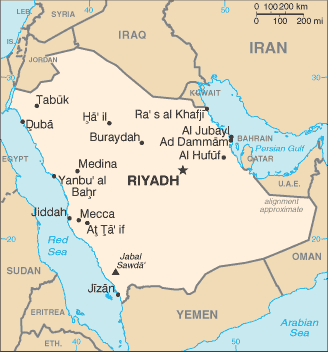Persecuted church list...
Map:

Overview:
In 1902, ABD AL-AZIZ bin Abd al-Rahman Al Saud captured Riyadh and set out on a 30-year campaign to unify the Arabian Peninsula. A son of ABD AL-AZIZ rules the country today, and the country's Basic Law stipulates that the throne shall remain in the hands of the aging sons and grandsons of the kingdom's founder. Following Iraq's invasion of Kuwait in 1990, Saudi Arabia accepted the Kuwaiti royal family and 400,000 refugees while allowing Western and Arab troops to deploy on its soil for the liberation of Kuwait the following year. The continuing presence of foreign troops on Saudi soil after Operation Desert Storm remained a source of tension between the royal family and the public until the US military's near-complete withdrawal to neighboring Qatar in 2003. The first major terrorist attacks in Saudi Arabia in several years, which occurred in May and November 2003, prompted renewed efforts on the part of the Saudi government to counter domestic terrorism and extremism, which also coincided with a slight upsurge in media freedom and announcement of government plans to phase in partial political representation. A burgeoning population, aquifer depletion, and an economy largely dependent on petroleum output and prices are all ongoing governmental concerns.
The People:
Population: 26,417,599
note: includes 5,576,076 non-nationals (July 2005 est.)
Age structure:
0-14 years: 38.2% (male 5,149,960/female 4,952,138)
15-64 years: 59.4% (male 8,992,348/female 6,698,633)
65 years and over: 2.4% (male 334,694/female 289,826) (2005 est.)
Religions:
Muslim 100%
Government Type:
monarchy
Leader(s) to pray for:
chief of state: King and Prime Minister ABDALLAH bin Abd al-Aziz Al Saud (since 1 August 2005); note - the monarch is both the chief of state and head of government
Source: The World Factbook
View All Countries